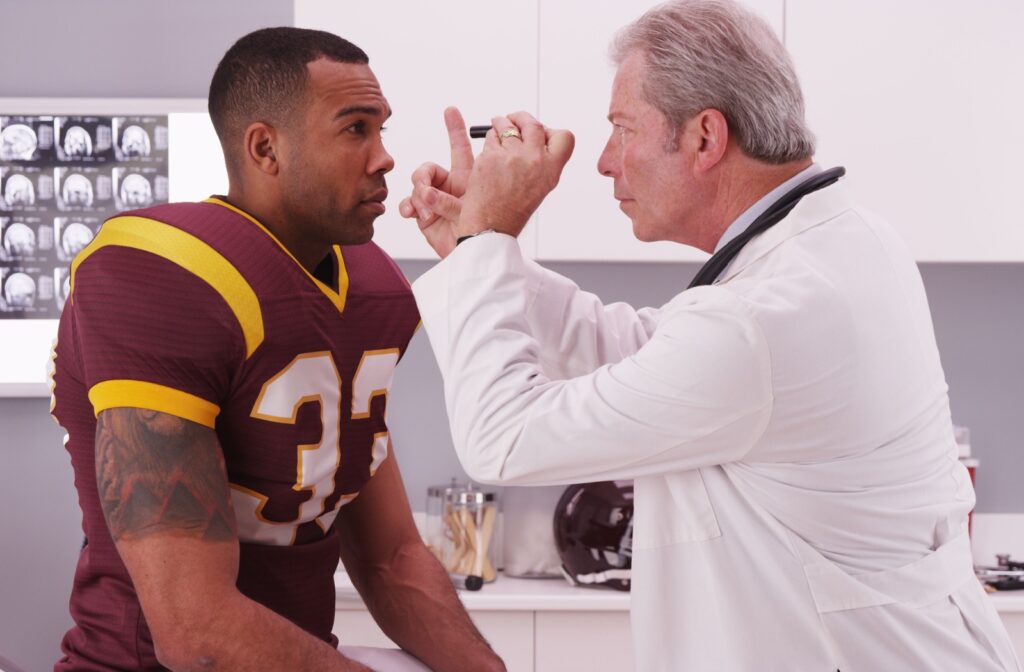A blow to the head can be unsettling, and it’s natural to worry about the signs of a brain injury. You may have heard that changes in your pupils—the black centers of your eyes—can indicate a problem.
While many factors can cause your pupils to change size, certain changes after a head injury can be a sign of a concussion. Specifically, if one pupil is noticeably larger than the other, it can point to a more serious issue that requires prompt medical attention.
If you suspect you have a concussion, contact us for immediate care.
What Is a Concussion?
A concussion is a type of brain injury that happens after a jolt, bump, or blow to the head. The impact causes the brain to move back and forth quickly inside the skull, causing bruising which in turn disrupts how your brain normally works and communicates.
Common Causes of a Concussion
- Falls
- Car accidents
- Contact sports
- Hard hits to the body
General Signs to Watch For
- Headache or neck pain
- Nausea
- Drowsiness or fatigue
- Confusion or memory problems
- Sensitivity to light or sound
- Changes in mood
The Connection Between Your Eyes & Brain
Your ability to see relies on a strong connection between your eyes and your brain. In fact, a large portion of your brain is dedicated to processing visual information. That’s why an injury to the brain can affect your eyesight.
How a Concussion Affects Your Pupils & Vision
Changes in your pupils can occur after a head injury, but they are just one piece of a larger puzzle. It’s helpful to know what to look for and what these signs might mean. Many other visual symptoms can also appear after a concussion.
Dilated or Uneven Pupils Explained
Pupil dilation on its own is not always a reliable sign of a concussion. Your pupils can get larger for many reasons, like changes in light, stress, or excitement. However, a significant difference in size between your two pupils—a condition called anisocoria—after a head injury is a more serious concern.
Other Vision-Related Symptoms
- Blurry or double vision
- Light sensitivity
- Difficulty with focus
- Eye strain
- Trouble with object track
- Atypical eye movements
- Droopy eyelids

When to Seek Immediate Medical Attention
Some symptoms that appear after a head injury are red flags that require prompt medical care. Knowing these signs can help you act quickly when it matters most.
Red Flags After a Head Injury
- One pupil larger than the other
- A headache that gets worse and does not go away
- Repeated vomiting or nausea
- Seizures or convulsions
- Unusual behavior, confusion, or restlessness
- Slurred speech
- Weakness or numbness
- Loss of consciousness—even for a short time
Concussion Recovery & Your Eye Health
Recovering from a concussion is a gradual process that involves rest and a slow return to your daily activities. Paying attention to your eye health can support a smoother recovery.
Because head injuries can be serious, we always recommend visiting a medical professional to get yourself checked out, even if symptoms seem minor.
Initial Steps for Recovery
For the first 24 to 48 hours, rest is key to helping your brain begin to heal. You may need to limit activities that require a lot of focus, such as screen time. After this initial period, you can gradually add light activity back into your routine as symptoms allow. We recommend following the guidance of your medical professional.
The Role of an Eye Doctor After a Concussion
If vision problems continue after a concussion, it’s a good idea to visit your eye doctor. Persistent symptoms like double vision or eye strain can slow your recovery. We can assess your visual system and suggest therapies to help manage your symptoms.
At Total Vision El Cajon, our passion is protecting your vision. Let us help you navigate your eye health with care and proactive support.
If you’re experiencing ongoing vision issues after a head injury, contact us today. We can help you get the clarity you need to move forward in your recovery.


